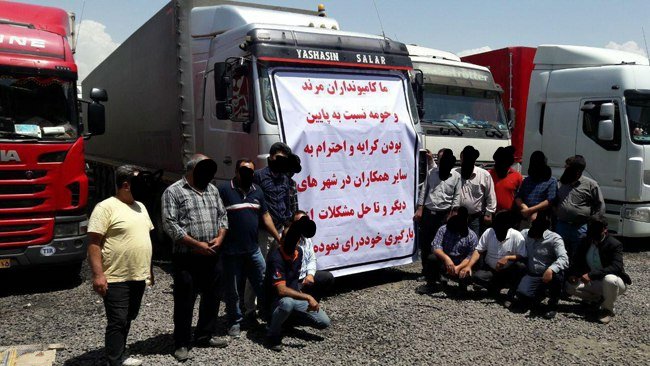Simultaneously with the continuation of protests and the continuation of strikes in recent days in some production centers of Iran, some reports indicate the formation of truckers’ strike in some parts of the country.
On Sunday, November 27, videos of truck drivers were published in which they announced that they were on strike despite the fact that they were given “remedial fuel” to encourage them.
“Union of Truckers and Drivers Organizations of Iran” channel has published some pictures and videos on Telegram and wrote that drivers are on strike in the cities of Qazvin, Bandar Abbas, Kermanshah, Saqqez and Shapur, Isfahan.
One of the truck drivers, by publishing a picture of a public text message to the drivers, immediately after announcing the call for a strike, says that they were informed that “ships carrying essential goods have docked at the ports” and that they will also receive “repair fuel”.
This is despite the fact that yesterday, the vice president of the country’s truck drivers union association said that “the authorities have not considered any solution to solve the fuel problem of truck drivers”. This government trade unionist claims truckers are protesting the removal of their fuel quota, but instead of restoring the entire quota and increasing it, the government “gives a small amount of fuel quota every month” which is insufficient and by delay.
In addition, Iran’s semi-government labour news agency (ILNA) reports that half of the nation’s truck fleet has worn out and is not in a operational state: “Approximately half of the 400,000 existing fleets are worn out, i.e. 188,000 vehicles, the renewal of the fleet has been planned, and it is essential that the fleet be renewed, since in addition to air pollution caused by the traffic of this worn-out fleet, it increases the amount of fuel consumed by this vehicles threefold.”
This government official says: “The issue of purchasing power in the implementation of the fleet renewal plan is a very important issue because we can implement negative plans such as banning the traffic of worn-out vehicles when the government supports the drivers of worn-out trucks. Today, when the price of trucks has increased, drivers have not that much income, nor are they able to pay high installments.”
The truckers’ strike is taking shape a day after reports of strikes were published in some factories and production centers, including Esfahan Steel Company.
In a report, the Free Union of Iranian Workers stated that the reason for the strike again by the workers and employees of Esfahan Steel Company is “failure to fulfill the promises of the officials regarding payment and salary increase”.
At the same time, it was reported that the workers of the industrial production company “Moratab” also went on strike in protest against the non-payment of their salaries for 9 months. The three industrial factories of Saif Khodro, SarmaAfarin Manufacturing Company and Pars Home Appliances Company in Alborz Industrial City were also among the companies whose workers’ strike on Saturday.
In more than 70 days that have passed since the beginning of the nationwide protests of “Woman, Life, Freedom” along with the strike of workers and employees of a significant number of production and industrial units, there has also been a strike by marketers and shopkeepers in many cities.
Iran’s truckers and drivers organized one of the longest strikes in the summer and fall of 2018. During this strike, which lasted for more than a month in some areas, dozens of truck drivers were arrested and threatened with death by the judicial authorities. In the spring of the same year, truck drivers went on strike.
In that year, the government used the cargo vehicles of the military institutions to deal with the drivers’ strike.










